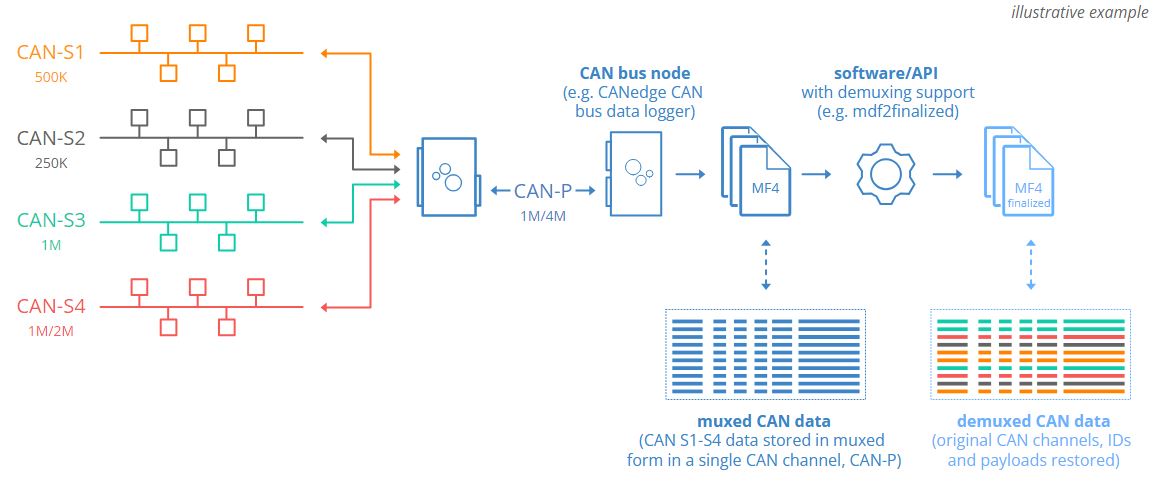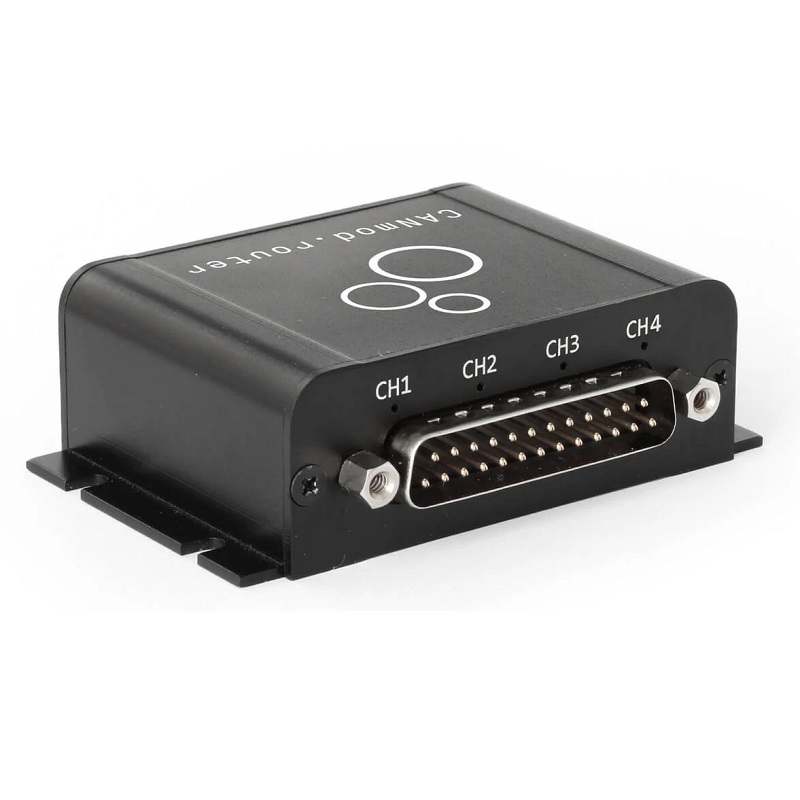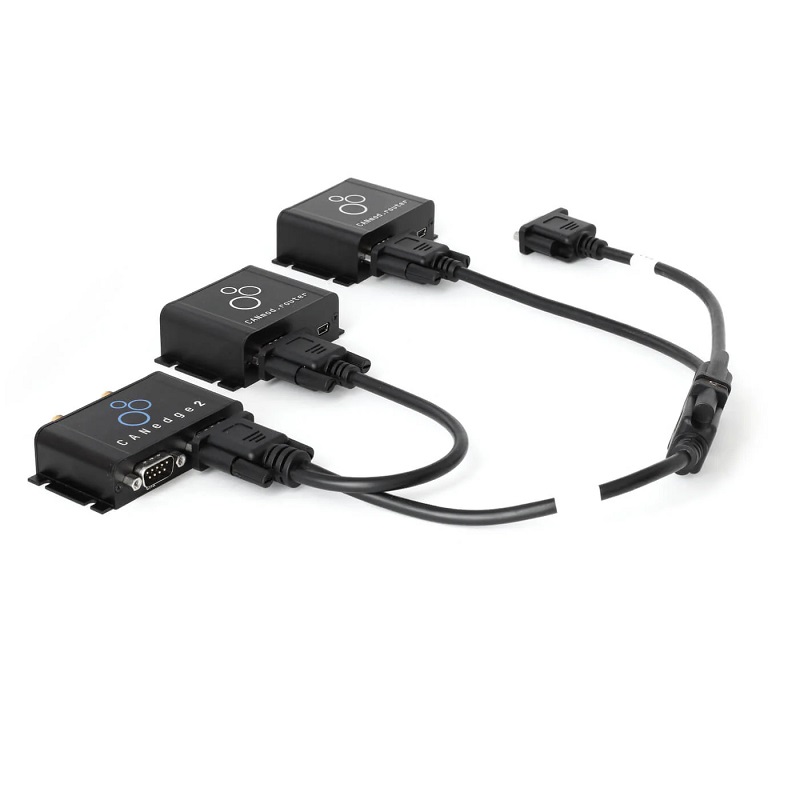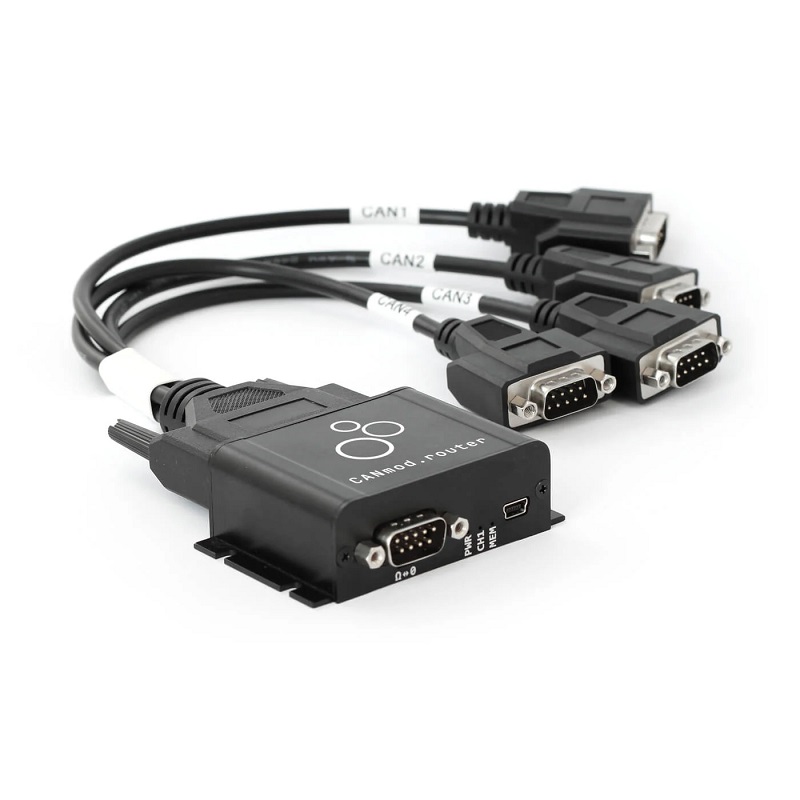Description
The CANmod.router lets you receive/transmit CAN data (Classical or FD) from/to 4 isolated secondary CAN buses via 1 primary CAN bus (or USB).
The compact module is 100% standalone (no PC required) and offers pro specs, daisy chaining and powerful configuration options.
It can e.g. be used with the CANedge, enabling you to log 5 x CAN buses (or beyond via daisy chaining).
The device can also be used as a powerful 4 x CAN FD to USB interface with free software/API tools.
Tip: Add the DB25-to-4x-DB9 for quick installation.
Outline
|
PLUG & PLAY |
Connect up to 4 x CAN to receive / transmit the data via 1 x CAN (or USB) - no configuration required |
|
COMPACT |
7 x 2 x 5 CM. 75G. 7 LEDs. Supply via DB9/USB. 5-26 V. Mounting flanges. USB for config/FW and streaming |
|
PRO SPECS |
4 x CAN FD. Basic galvanic isolation. Silent mode. Zero data loss. 1 ms precision. Error frame support. |
|
MUX MODE |
Transport 4 x CAN via 1 x CAN. Easily demux data. Optionally transport via CAN FD for max throughput |
|
SEAMLESS |
Fully supported by CANedge/CANmod software/API tools. As if directly interfacing the 4 x CAN buses |
|
CONFIGURABLE |
Configure filters, prescalers, transmit lists, CAN IDs, bit rates and more via JSON config and GUI |
Transport muxed CAN data through tunnels
In mux-mode, traffic from/to the secondary CAN buses is routed through the primary CAN bus via tunnels (CAN frames that transport the original data). Muxed data received by a user CAN node (e.g. CANedge) can be easily demuxed to its original form via software/API tools.

Interface four CAN buses with just one CAN bus (or USB)
Receive/transmit data from/to 4 x CAN buses via 1 x CAN bus (or USB) - e.g. for use by CAN loggers, ECUs or via USB streaming.
-
4 x CAN (incl. CAN FD) with basic galvanic isolation
-
Power via DB9 (5-26 V and DB9 cables) or USB (5V)
-
Independently configure each secondary CAN interface
-
Optional silent mode and independently customizable bit rates
-
Advanced message filters and prescalers
-
Configure transmit lists - and/or control via primary CAN
-
Support for CAN error frame logging
-
Quickly connect 4 x CAN via DB25-to-4x-DB9 adapter cable
-
Daisy chain multiple modules for 8, 12, 16, ... CAN channels
Specification
|
GENERAL |
|
|
Functionality |
The device routes data from four isolated CAN buses (incl. FD) to one primary CAN bus (or USB) |
|
Included |
CANmod.router module and USB dust cover (DB25-to-4x-DB9 adapter and USB adapter not included) |
|
Firmware |
Supports free firmware updates via USB for adding features
|
|
Configuration |
Configuration files based on the popular open source JSON schema concept (similar to the CANedge) |
|
Software |
-
Free open source editor tool for easy device configuration (offline/online version available)
-
Free open source SavvyCAN GUI for streaming of raw / DBC decoded data via USB
-
Free open source Python API for streaming of raw / DBC decoded data via USB
|
|
Safety |
CE, FCC, IC and RoHS certified (see the Docs for certificates) |
|
Warranty |
1-year warranty |
|
Origin |
Denmark |
|
ROUTER MODES |
|
|
Mux-Mode |
-
Traffic from/to secondary CAN buses is muxed and transported through 'tunnels' via primary CAN bus
-
Demuxing done via software/API tools to restore original CAN frames (channel IDs, CAN IDs, payloads)
-
CANmod software/API with demuxing: SavvyCAN, USB Python API
-
CANedge software/API with demuxing: MF4 Python API, mdf2mdf (and hence all CANedge tools)
|
|
CAN BUS (CAN-S) |
|
|
Channels |
4 x CAN channels (incl. CAN FD support) |
|
Isolation |
Basic galvanic isolation (easily connect CAN buses not subject to high voltage differences) |
|
Standard |
ISO 11898: Compliant with CAN (between 5K and 1 Mbit/s baud rates) and CAN FD (1M, 2M, 4M, 5M) |
|
Protocols |
Receive/transmit raw data from/to CAN based protocols (J1939, CANopen, NMEA 2000, OBD2, UDS, ...) |
|
Identifiers |
Compliant with CAN specifications 2.0A (11-Bit ID) and 2.0B (29-Bit ID) |
|
Retransmission |
Retransmission of frames that have lost arbitration or been disturbed by errors |
|
Transceiver Protection |
-
Protection: +/- 25kV HBM ESD, +/-12kV IEC ESD, +/-14 V bus fault, short circuit
-
Common mode input voltage: +/-12V
-
TXD dominant timeout (prevents network blocking in the event of a failure)
|
|
CAN BUS (CAN-P) |
|
|
Channels |
1 x CAN channel (incl. CAN FD support) |
|
Modes |
The device can either broadcast the data onto the CAN bus - or provide it on-request |
|
Standard |
ISO 11898: Compliant with CAN (between 5K and 1 Mbit/s baud rates) and CAN FD (1M, 2M, 4M, 5M) |
|
Identifiers |
Compliant with CAN specifications 2.0A (11-Bit ID) and 2.0B (29-Bit ID) |
|
Termination |
Termination can be toggled via switch below DB9 connector |
|
Retransmission |
Retransmission of frames that have lost arbitration or been disturbed by errors |
|
Transceiver Protection |
-
Protection: +/- 25kV HBM ESD, +/-12kV IEC ESD, +/-14 V bus fault, short circuit
-
Common mode input voltage: +/-12V
-
TXD dominant timeout (prevents network blocking in the event of a failure)
|
|
CONFIG (CAN-S) |
|
|
Independence |
Each secondary CAN channel can be independently configured (router mode is set globally) |
|
Bit Rate |
Select between standard bit rates (5K to 1M) or use custom bit-timing |
|
Bit-Rate Auto-Detect |
Bit rates can be set manually (auto-detection pending FW) |
|
Silent Mode |
Configurable silent mode: Restricted (acknowledge only) or monitoring (zero transmission) |
|
Filters |
32 regular/extended ID filters per channel (mask, acceptance, rejection) |
|
Prescalers |
Prescale CAN frames to record e.g. by time (per X ms) or by data (e.g. if byte X or Y changes) |
|
Transmit |
-
Transmit lists of up to 16 CAN frames per channel (single-shot/periodic)
-
Transmission can also be directly controlled from the CAN-P interface
|
|
CAN Error Frames |
Support for logging CAN error frames (bit-stuffing, form, CRC, bit, acknowledgement) |
|
CONFIG (CAN-P) |
|
|
Bit Rate |
Select between standard bit rates (standard: 5K to 1M, FD: 1M to 4M) or use custom bit-timing |
|
Identifier Customization |
Individually configure each CAN ID (11-bit or 29-bit) |
|
OTHER |
|
|
Precision |
Cross-channel precision of 1 ms |
|
Frames/Second |
Mux-mode: Route 8,000+ frames/second (Classical CAN) - see FAQ for details |
|
ELECTRICAL |
|
|
Input Supply |
-
+5V to +26V DC via the DB9 connector (power via pin 1 or pin 9)
-
Alternatively power via USB (for updating firmware/config or for streaming data in real-time)
|
|
Power Consumption |
Extremely low (<1W) - no risk of battery drainage |
|
Protection |
-
Reverse voltage protection on CAN-bus supply
-
Transient voltage event protection on supply lines
|
|
MECHANICAL |
|
|
Enclosure & Weight |
Compact aluminium enclosure: 65 x 48 x 24 mm (W x L x H excl. flanges & connectors). 75 grams |
|
Connector (Front) |
1 x Standard D-sub 9 (DB9) connector |
|
Connector (Back) |
1 x D-sub 25 (DB25) connector |
|
Pin-Out |
See the product manual for the DB9/DB25 connector pin-outs |
|
USB |
Standard mini USB connector for config/FW updates and streaming (USB cable available as option) |
|
LEDs |
Module status via 7 external LEDs: Power, CAN-P, Memory, CAN-S1, CAN-S2, CAN-S3, CAN-S4 |
|
Temperature |
Operating temperature: -25degC to +70degC |
|
IP Rating |
IP Rating 40 |
|
Mounting |
Module can be mounted via e.g. velcro strips or mounting kit |


